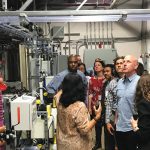
MTC’s Horizon planning initiative explored “what-if” scenarios to make sure the region is better prepared to address varying degrees of unpredictability.
Futuristic hyperloop pods that whisk commuters around the region are a flashy idea, but not one that Bay Area transportation planners are betting on today.
Looking at key proposed projects — like a new San Francisco/East Bay rail connection — it’s clear that planners are doubling down on public transit to provide fair, sustainable, and accessible transportation in the region 45 years from now and beyond. Staff at the Metropolitan Transportation Commission and Association of Bay Area Governments will determine this fall if a new Transbay rail crossing and roughly two dozen other recommended draft blueprint strategies will be included in Plan Bay Area (PBA) 2050, the long-range plan updated every four years.
“Most of these strategies have not been considered or included in previous iterations of Plan Bay Area,” said Dave Vautin, assistant director of major plans at MTC.
This time around, MTC and ABAG staff took a new approach. Their Horizon planning initiative explored “what-if” scenarios to make sure the region is better prepared to address varying degrees of unpredictability. That includes a future in which an economic downturn would threaten transportation funding, now materializing as a significant concern. The global outbreak of COVID-19 and related transit ridership disruptions show why planning exercises are necessary to combat the unforeseen.
“While we didn’t study a pandemic, we have explored what it means for our region to experience economic shock and that’s research that’s helpful in the months ahead,” Vautin said.
A collaboration of San Francisco transportation planners also are working on ConnectSF, a 50-year vision to build an effective, equitable, and sustainable transportation system that helps take more cars off roads. The multi-agency effort is in a community feedback-gathering phase to produce two studies: one focused on streets and freeways and the other on transit corridors.
“People are excited about the future in terms of transportation innovation, but want projects and investments that work to improve their lives,” said Bradley Dunn, public information officer at the San Francisco Municipal Transportation Agency.
Bay Area commuters often complain that getting around the region is costly and inefficient. The amount of time spent in highway congestion alone has risen 25 percent since the dot-com boom’s peak. To address this problem, planners, advocates, and officials are tapping into ideas that are more rational than radical to advance the region’s transportation future.
“Emerging mobility is a combination of technological changes and behavior changes, both influenced by decisions we make as individuals, as well as government agencies setting policy,” said Terra Curtis, a principal at the San Francisco-based transportation planning firm Nelson\Nygaard.
Emerging mobility options — car, ride, and scooter shares; e-bikes; and autonomous cars and shuttles — will continue to evolve and support public transit, Curtis said. These options will help fill first-and-last-mile connections to more densely housed transit hubs where residents can travel around the Bay Area and eventually to new destinations.
It’s actually an experience that’s “fairly common in other parts of the world,” said Sebastian Petty, director of policy development at Caltrain, which is working toward the rollout of its electrified fleet and more frequent, faster, and expanded lines under its 2040 service vision. In the future, automated shuttles are expected to connect riders to transit hubs amid growing importance of regional service. In preparation for that future, driverless technology company EasyMile has worked with Bay Area transportation agencies such as the Contra Costa Transportation Authority and the Livermore Amador Valley Transit Authority to test shuttles as part of pilot projects.
Sources interviewed by the Monitor also talked about the ways in which congestion pricing will reduce traffic while lower speed limits and more bike lanes will increase safety and improve access on complete streets. Furthermore, various systematic revamps are being proposed to reconcile all the disparate transit fare ticketing seen today.
Still, the biggest game-changer could be a new Transbay rail crossing.
A second crossing between San Francisco and the East Bay would help reduce delays, double BART’s Transbay capacity, and allow passengers to ride a single train to destinations throughout Northern California. The proposed project includes BART and regional rail partners, and would connect existing rail services such as Capitol Corridor and Caltrain, serving stops in Sacramento, Stockton, the Peninsula, and Monterey, all of which are part of the broader megaregion.
“We think it’s the biggest transformational project we could do for the region and hopefully the megaregion,” said Sadie Graham, BART’s acting director for the new Transbay rail crossing. “It will transform the way people travel and access destinations throughout Northern California.”
The crossing is a strategy that would only be included in PBA’s “blueprint plus” category when sufficient revenues are available. The full project is estimated to cost at least $30 billion in today’s dollars, according to MTC.
“The crossing could accommodate BART trains, standard gauge trains, or both on separate tracks. Consideration is also being given to both trains sharing dual-gauge tracks. But those are all technical considerations that would require further study,” Graham said.
Integration opportunities also need a closer look to determine how a future regional rail network should or could be created to blend and balance service to multiple markets. Major infrastructure investments, including California High-Speed Rail and Caltrain electrification, could be leveraged to spur greater regional connection, transit officials said.
“Our long-term future is part of a tighter Bay Area transportation network,” said Petty, adding that Caltrain’s service vision directs it to continue planning for potential new regional and megaregional connections.
Currently, ideas about different transit providers eventually operating as one system are mostly related to fares and payments. One strategy being analyzed for potential inclusion in the final PBA 2050 calls for making trip planning and payment more seamless through a platform accessible via smartphone. Another recommends an integrated fare structure across all operators, replacing each one’s specific discounted fare programs.
However, there would be multiple operational complexities to sort through, including how the streamlining of fares hurts operators heavily dependent on fare-box revenue.
Advocates acknowledge revenue concerns but stress that riders will continue to suffer from lack of fare and schedule coordination in the future should the region’s 27 transit operators operate in silos. Seamless Bay Area, a group campaigning for a unified regional transit network, has sponsored Assembly Bill 2057 (Chiu), which lays out ways to simplify transit riders’ experience.
“We need to have an empowered regional transportation authority that can truly facilitate a transportation vision that makes sense, and results in a logical, competitive transportation network,” said Ian Griffiths, Seamless Bay Area’s co-founder and director.
Would a hyperloop ever be a part of the network? Staff working on PBA studied the possibility as part of “back to the future” planning when exploring high-speed rail alternatives. But they ruled it out because capacity would be low, it’s not fully proven, and, at this point, no one knows if it will come to fruition, Vautin said.
Transportation planning is cyclical in nature, too. Consider BART, which is now transitioning to a new fleet, replacing cars that have been in use since the rail operator’s inception in the early ’70s. “We’ll kind of be in the same situation 45 years from now, looking at the third generation,” said Jim Allison, manager of media relations at BART.
Cecily O’Connor covers transportation for the Monitor.

